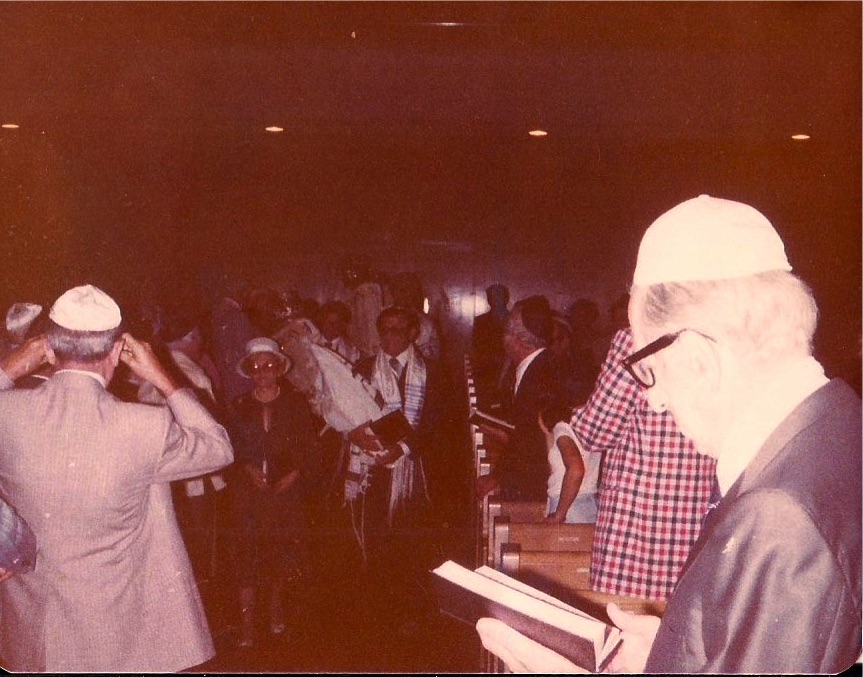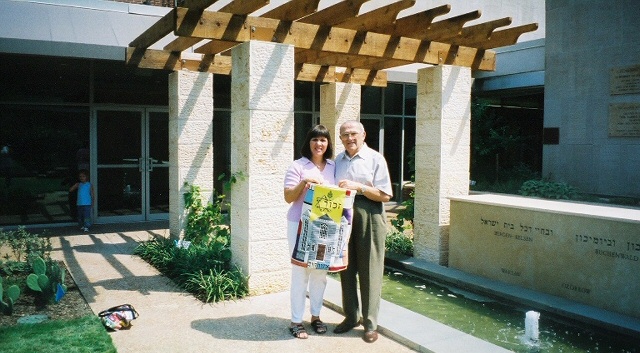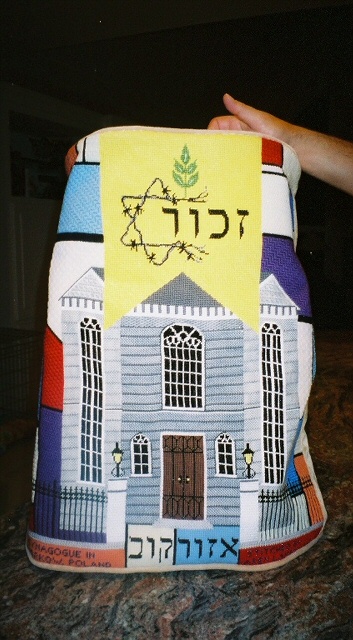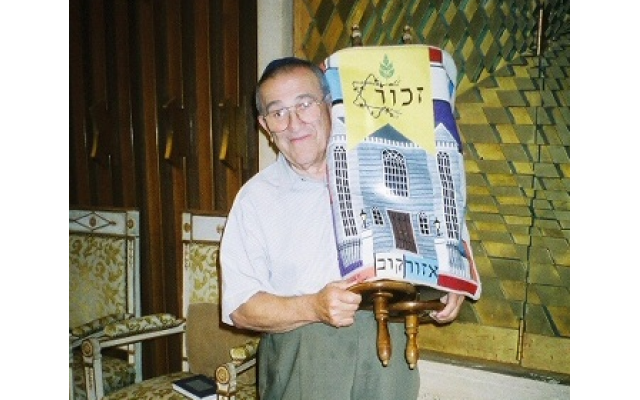Torah Rededication Links Family’s Past and Present
A Torah scroll that survived the Holocaust from Ozorkow, Poland was recently refurbished and will be rededicated at Ahavath Achim Synagogue.
Dave Schechter is a veteran journalist whose career includes writing and producing reports from Israel and elsewhere in the Middle East.
Karen Lansky Edlin was 19 years old when the Ahavath Achim Synagogue dedicated a Torah that survived the destruction of the Jewish community in Ozorkow, Poland, during the Holocaust.
That ceremony, on Sunday, Aug. 14, 1977, was the culmination of a two-year effort by Karen’s parents, Rubin and Lola Lansky, to secure the sacred scroll from a town central to their life story.
“As the Torah was brought in, the shofar was sounded! I was astounded. I had never heard a shofar blown outside of a major holiday,” Lansky Edlin recalled. “I knew that this was an important day. And an important event.”
More than four decades later, on Sunday, Jan. 5, 2020, the refurbished Ozorkow Torah will be rededicated at Ahavath Achim. The 1 p.m. ceremony is open to the public
“Today, I smile a huge smile as we talk about rededicating the Ozorkow Torah. I have been to Ozorkow, I can imagine how the town looked; I see all the faces that lived in the town and I smile that they have not been forgotten,” Lansky Edlin said.
When the Holocaust began, some 5,000 Jews lived in Ozorkow, located in central Poland, north of Lodz and west of Warsaw. There was a thriving Jewish merchant and tradesman class.
Lola Borkowska grew up in Lodz and spent summers visiting grandparents in Ozorkow and Parzeczew.
When the Germans invaded Poland in 1939, Lola and her siblings fled to their grandparents in Parzeczew, until they were sent to Ozorkow in 1940. There, the Nazis assembled the Jews to witness other Jews being hanged, then divided the community by those selected to work and those transported to the Chelmno extermination camp, where an estimated 2,000 died, including Lola’s grandparents and young cousins.
Lola and her family were sent to the Ozorkow ghetto, and in 1942 to the Lodz ghetto. When the Lodz ghetto was liquidated in 1944, they were transferred to the Auschwitz-Birkenau death camp in Poland (where Lola survived an inspection by the Nazi Dr. Josef Mengele). From there, Lola, her mother, and sister were sent to a series of camps; Ravensbruck, Muhlhausen, and finally to Bergen-Belsen, which Lola described as “hell on earth” in an oral history.

Among the prisoners Lola encountered at Bergen-Belsen were a pair of Dutch sisters, Margot and Anne Frank, whose family hiding place in an Amsterdam warehouse had been betrayed to the Gestapo. Both girls died there of typhus in February 1945. Lola’s mother died of illness one day before British troops liberated Bergen-Belsen in April 1945. What remained of the family – Lola, her sister Helen, her brother Lou and their father Michael – reunited at the Feldafing displaced persons camp, an all-Jewish camp in the U.S. zone of post-war Germany.
Rubin Lansky was a native of Ozorkow. He had been arrested at 17 and sentenced to work on the German Autobahn (highway) and railroads, and moved between camps in Latvia, Estonia, and Germany. He escaped into Czechoslovakia, eventually returning to Orzokow, where he learned he was the lone survivor of his immediate family.
Rubin sought any surviving relatives at Feldafing. He found Lola, a distant cousin he had met as a child. “Actually a very funny story,” Lansky Edlin said. “My Dad went looking for my mother because he heard that she had nice legs.” Rubin found her in the camp hospital. “And, yes, he liked her legs.”
Lola, her father, and siblings arrived in New York on June 24, 1946. Rubin followed on Jan. 5, 1947. They were married Nov. 23, 1947, in New York. In 1953, Rubin, Lola, and their son Murray moved to Atlanta, where Karen was born. Rubin operated a grocery in East Point and then built a successful real estate business.
As founding members of Eternal Life-Hemshech, Inc., an organization of survivors and their descendants, the Lanksys were instrumental in creation of the Holocaust memorial at Greenwood Cemetery and the Holocaust exhibit at The Breman Museum.
Their daughter, who today is president of Eternal Life-Hemshech, remembers her mother speaking publicly about the Holocaust at a time when most survivors did not.

Rubin and Lola returned to Poland in 1975, their first visit since the war. In Ozorkow, they were directed to Tobias Drajhorn, apparently the only remaining Jew. Drajhorn and his uncle, Israel Frydman, had hid their synagogue’s Torah in the attic of its shtibl, a small house of prayer on the grounds. After the war, Drajhorn found the Torah still in the shtibl and for 30 years kept it in his home.
As Poland was under Communist rule, the Lanskys were afraid to accept the Torah. When they returned home, Rabbi Harry Epstein drafted a letter, requesting that the Torah be donated to Ahavath Achim, allowing Drajhorn to request a government permit. A separate historical society permit had to be obtained, promising that the Torah would not be used for profit.
A few weeks later, “My mother and I come home one day and there’s a huge crate just sitting at the front door,” Karen Lansky Edlin said. “We had no warning it was coming.” The Torah was wrapped in white cloth. An inspection determined that the scroll, believed to be 150 to 200 years old, still met the requirements for use in services.
In an October 1976 letter to the Lanskys, Drajhorn’s wife wrote that when her husband learned that “his last living link with the past” had arrived, “he was so overcome with tears, he was so happy. He was beside himself that the Torah could be used again.”

On the day the Torah was presented to Ahavath Achim, Lola wrote to the congregation: “It is with pride and joy my husband and I present this old Sacred Sefer Tora from the city of Ozorkow Poland in honor of Tobias Drajhorn, the last living Jew in the city and in loving memory of the Jewish Community that perished in the Holocaust.”
Lola died in 1999, Rubin in 2005.
Karen and her husband, Andy Edlin, arranged for the Torah to be refurbished by a sofer, a Torah scribe, in Miami, work that began in November 2018 and lasted for 10 months.
At Ahavath Achim, Rabbi Laurence Rosenthal is grateful for the presence of the Orzokow Torah. “Where, once upon a time, it was so fragile that we could only use it a few times a year and only one reading [on Yizkor], now we use it all year round. In fact, we are encouraged to do so to keep the pages limber and the text free from cracking and other issues that Torah scrolls often go through,” he said. “On the spiritual level, having this scroll, with what it survived and the communities that it represents, is like having those souls with us when we read it.”
Lansky Edlin said, “My mother always told me that people told her in the camps, ‘Don’t forget us.’ We have not forgotten. We are so happy to be able to continue the legacy that my parents started. And as long as the Torah could be living, that is what they wanted.”




comments